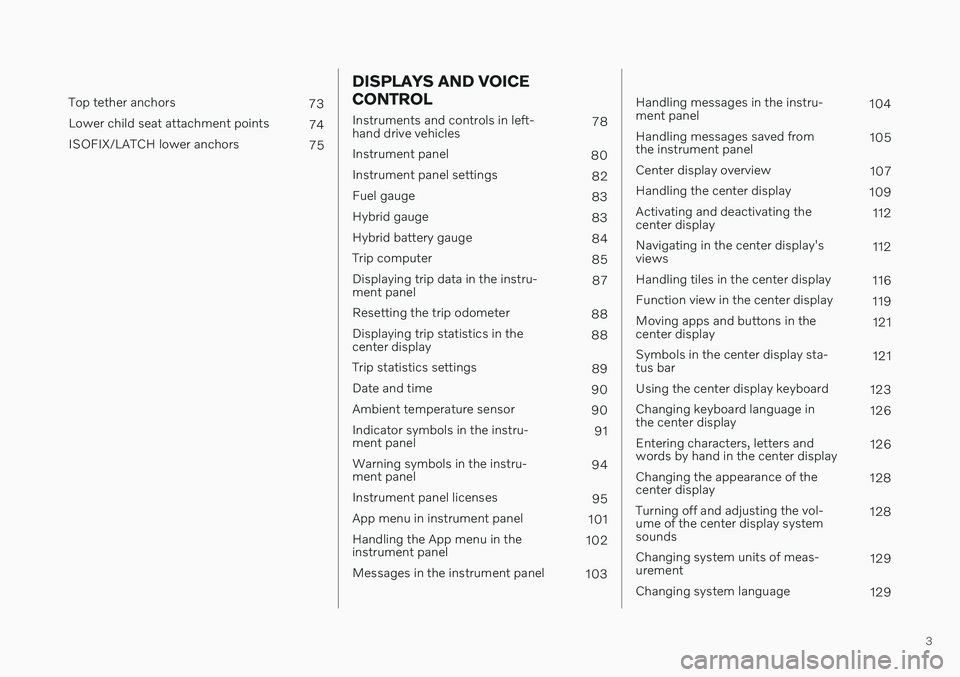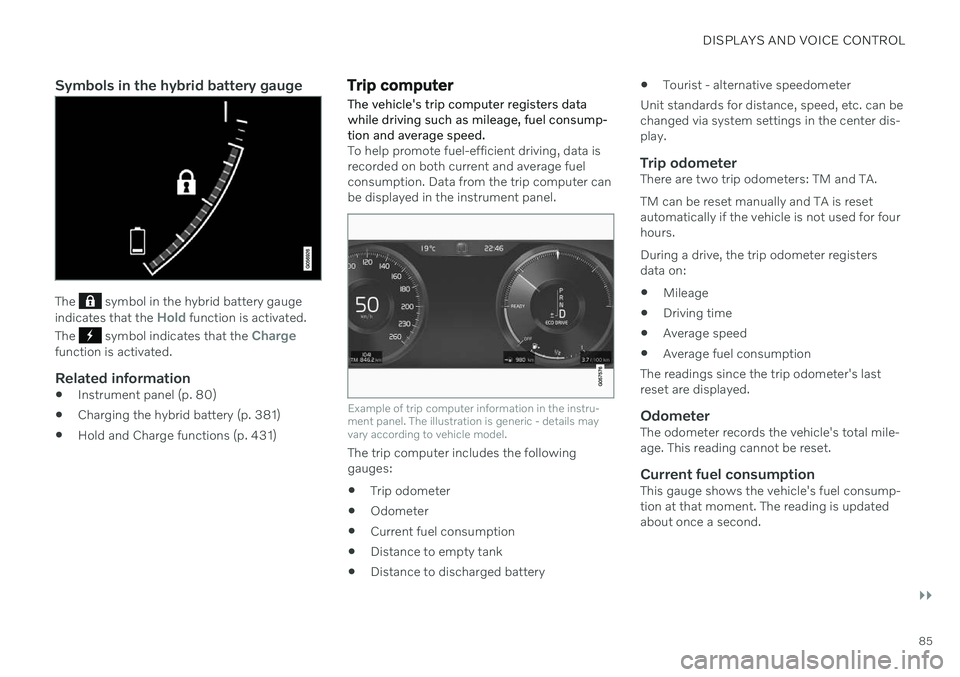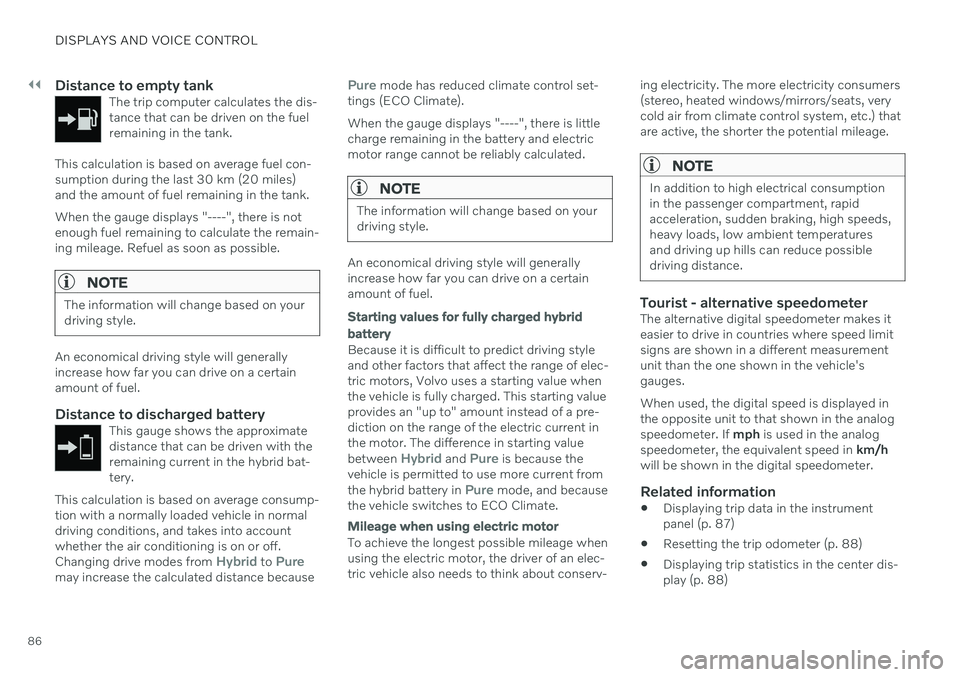hybrid VOLVO S90 TWIN ENGINE 2020 Owners Manual
[x] Cancel search | Manufacturer: VOLVO, Model Year: 2020, Model line: S90 TWIN ENGINE, Model: VOLVO S90 TWIN ENGINE 2020Pages: 655, PDF Size: 12.54 MB
Page 5 of 655

3
Top tether anchors73
Lower child seat attachment points 74
ISOFIX/LATCH lower anchors 75
DISPLAYS AND VOICE CONTROL
Instruments and controls in left- hand drive vehicles78
Instrument panel 80
Instrument panel settings 82
Fuel gauge 83
Hybrid gauge 83
Hybrid battery gauge 84
Trip computer 85
Displaying trip data in the instru-ment panel 87
Resetting the trip odometer 88
Displaying trip statistics in thecenter display 88
Trip statistics settings 89
Date and time 90
Ambient temperature sensor 90
Indicator symbols in the instru-ment panel 91
Warning symbols in the instru-ment panel 94
Instrument panel licenses 95
App menu in instrument panel 101
Handling the App menu in theinstrument panel 102
Messages in the instrument panel 103
Handling messages in the instru- ment panel 104
Handling messages saved fromthe instrument panel 105
Center display overview 107
Handling the center display 109
Activating and deactivating thecenter display 112
Navigating in the center display'sviews 112
Handling tiles in the center display 116
Function view in the center display 119
Moving apps and buttons in thecenter display 121
Symbols in the center display sta-tus bar 121
Using the center display keyboard 123
Changing keyboard language inthe center display 126
Entering characters, letters andwords by hand in the center display 126
Changing the appearance of thecenter display 128
Turning off and adjusting the vol-ume of the center display systemsounds 128
Changing system units of meas-urement 129
Changing system language 129
Page 11 of 655

9
Park Assist Camera*
362
Location and field of vision of Park Assist Cameras * 363
Park Assist Camera trajectory lines *
365
Park Assist sensor field 366
Activating Park Assist Camera 368
Park Assist Camera symbols and messages 369
Park Assist Pilot *
370
Types of parking with Park Assist Pilot * 371
Using Park Assist Pilot *
372
Leaving a parallel parking spacewith Park Assist Pilot *374
Park Assist Pilot * limitations
375
Park Assist Pilot * messages
377
HYBRID INFORMATION
General information about Twin Engine 380
Charging the hybrid battery 381
Charging current 383
Charge cable 383
Charging cable residual current device 385
Charging cable temperature moni-toring 386
Opening and closing the chargingsocket cover 386
Initiating hybrid battery charging 386
Charging status in the vehicle'scharging socket 388
Charging status in the chargingcable's charging module 389
Charging status in the instrumentpanel 390
Stopping hybrid battery charging 392
Twin Engine symbols and mes-sages in the instrument panel 394
Long-term storage of vehicleswith hybrid batteries 396
STARTING AND DRIVING
Starting the vehicle
398
Switching off the vehicle 400
Ignition modes 401
Selecting ignition mode 402
Brake functions 403
Brakes 403
Brake Assist System 405
Braking on wet roads 405
Braking on salted roads 406
Maintenance of the brake system 406
Parking brake 406
Activating and deactivating the parking brake 407
Settings for automatically activat-ing the parking brake 408
Parking on a hill 409
Parking brake malfunction 409
Auto-hold brakes 410
Activating and deactivating Auto-hold at a standstill 411
Hill Start Assist 411
Braking assist after a collision 412
Transmission 412
Automatic transmission 412
Gear selector positions for auto-matic transmissions 413
Page 12 of 655

10
Using the steering wheel paddles*
to shift 415
Shiftlock 416
The kickdown function 417
All Wheel Drive (AWD) 417
Drive systems 418
Starting and stopping the com- bustion engine in Twin Enginevehicles 419
Drive modes 419
Changing drive mode 423
Energy distribution in hybrid mode using map data *424
Leveling control * and suspension
425
Leveling control settings *
428
Economical driving 428
Factors affecting electric motor range 429
Hold and Charge functions 431
Preparing for a long trip 432
Winter driving 432
Driving through standing water 433
Opening/closing the fuel filler door 434
Refueling 435
Fuel 436
Octane rating 437
Emission controls 439
Overheating of engine and trans- mission439
Battery drain 440
Jump starting using another battery 441
Towing using a towline 443
Attaching and removing the tow-ing eyelet 443
Recovery 444
HomeLink ®
* 445
Programming HomeLink ®
* 446
Using HomeLink ®
* 448
Type approval for HomeLink ®
* 448
Compass *
449
Activating and deactivating the compass * 449
Calibrating the compass *
450
AUDIO, MEDIA AND INTERNET
Audio, media and Internet
452
Sound settings 452
Sound experience *
453
Apps 454
Download apps 455
Updating apps 455
Deleting apps 456
Radio 456
Starting the radio 457
Changing waveband and radio station 458
Searching for a radio station 458
Storing radio channels in the Radio favorites app 459
Radio settings 460
RBDS 460
HD Radio ™
461
Activating and deactivating the HDRadio ™ 462
HD Radio ™ sub-channels
462
HD Radio ™ limitations
463
SiriusXM ®
Satellite radio *
464
Using SiriusXM ®
Satellite radio *
465
Settings for SiriusXM ®
Satellite radio *
466
SiriusXM Travel Link ®
* 468
SiriusXM Travel Link ®
* - Weather
469
Page 15 of 655

13
LOADING, STORAGE AND PASSENGER COMPARTMENT
Passenger compartment interior552
Tunnel console 553
Electrical outlets 554
Using the electrical outlets 554
Using the glove compartment 555
Sun visors 557
Folding down the armrest in the rear seat * 557
Cargo compartment 558
Loading recommendations 558
Roof loads and load carriers 559
Grocery bag holders 560
Load anchoring eyelets 560
Rear seat ski hatch *
560
MAINTENANCE AND SERVICE
Volvo's service program
562
Data transfer between vehicle and workshop over Wi-Fi 565
Download Center 565
Handling system updates viaDownload Center 566
Vehicle status 567
Scheduling service and repairs 567
Sending vehicle information to theworkshop 568
Hoisting the vehicle 569
Climate control system service 571
Replacing a windshield with head- up display * 571
Opening and closing the hood 571
Engine compartment overview 573
Engine oil 574
Checking and filling engine oil 575
Refilling coolant 576
Replacing bulbs 578
Start battery 579
Hybrid battery 583
Battery symbols 584
Battery recycling 584
Fuses and fuseboxes 585
Replacing fuses 585
Fuses in the engine compartment 587
Fuses under the glove compartment 594
Fuses in the trunk 600
Cleaning the interior 605
Cleaning the center display 605
Cleaning the head-up display *
606
Cleaning fabric upholstery and ceiling liner 607
Cleaning the seat belt 607
Cleaning floor mats and inlay mats 607
Cleaning leather upholstery *
608
Cleaning the leather steering wheel 609
Cleaning interior plastic, metal andwood surfaces 609
Cleaning the exterior 610
Polishing and waxing 610
Hand washing 611
Automatic car washes 613
High-pressure washing 614
Cleaning the wiper blades 614
Cleaning exterior plastic, rubberand trim components 615
Cleaning rims 616
Corrosion protection 616
Paintwork 617
Page 30 of 655

YOUR VOLVO
28
Drive-E ‒ purer driving pleasure
Volvo is committed to the well-being of its customers. As a natural part of this commit-ment, we care about the environment inwhich we all live. Concern for the environ-ment means an everyday involvement inreducing our environmental impact.
Volvo's environmental activities are based on a holistic view, which means we consider theoverall environmental impact of a productthroughout its complete life cycle. In this con-text, design, production, product use, andrecycling are all important considerations. Inproduction, Volvo has partly or completelyphased out several chemicals including CFCs,lead chromates, asbestos, and cadmium; andreduced the number of chemicals used in ourplants 50% since 1991. Volvo was the first in the world to introduce into production a three-way catalytic converterwith a Lambda sond, now called the heatedoxygen sensor, in 1976. The current version ofthis highly efficient system reduces emissionsof harmful substances (CO, HC, NOx) from theexhaust pipe by approximately 95 - 99% andthe search to eliminate the remaining emis-sions continues. Volvo is the only automobilemanufacturer to offer CFC-free retrofit kits forthe air conditioning system of all models as farback as the 1975 model 240. Advanced elec-tronic engine controls and cleaner fuels arebringing us closer to our goal. In addition to continuous environmental refinement of con-ventional gasoline-powered internal combus-tion engines, Volvo is actively looking atadvanced technology alternative-fuel vehicles. When you drive a Volvo, you become our part- ner in the work to lessen the vehicle's impacton the environment. To reduce your vehicle'senvironmental impact, you can:
Maintain proper air pressure in your tires.Tests have shown decreased fuel econ-omy with improperly inflated tires.
Follow the recommended maintenanceschedule in your Warranty and ServiceRecords Information booklet.
Drive at a constant speed whenever possi-ble.
See a trained and qualified Volvo servicetechnician as soon as possible for inspec-tion if the check engine (malfunction indi-cator) light illuminates, or stays on afterthe vehicle has started.
Properly dispose of any vehicle-relatedwaste such as used motor oil, used batter-ies, brake pads, etc.
When cleaning your vehicle, please usegenuine Volvo car care products. All Volvocar care products are formulated to beenvironmentally friendly.
Twin Engine vehicles
If possible, precondition the vehicle withthe charging cable before driving.
If preconditioning is not possible in coldweather, use the seat and steering wheelheating primarily. Avoid heating the entirepassenger compartment, which reducesthe hybrid battery's charge level.
Choose the
Pure drive mode to help mini-
mize electric power consumption.
In hilly terrain, put the gear selector in mode
B to utilize the electric motor's
braking function when the acceleratorpedal is released. This helps charge thehybrid battery.
Related information
Economical driving (p. 428)
Starting and stopping preconditioning(p. 225)
Air quality (p. 200)
Page 82 of 655

DISPLAYS AND VOICE CONTROL
* Option/accessory.
80
Instrument panel The instrument panel displays information related to the vehicle and driving.
The instrument panel contains gauges, indica- tors and monitoring and warning symbols.What is shown in the instrument panel variesdepending on the equipment, settings andfunctions currently active. The instrument panel is activated as soon as a door is opened, i.e. in ignition mode 0. The
panel will power down after a short period oftime if it is not used. To reactivate it, do one ofthe following:
Depress the brake pedal.
Activate ignition mode
I.
Open one of the doors.
WARNING
If the instrument panel turns off, does not activate when the ignition is switched on,or part/all of the panel cannot be read, donot drive the vehicle. Consult a workshopimmediately. Volvo recommends anauthorized Volvo workshop.
WARNING
If the instrument panel is not functioning properly, information about brakes, airbagsor other safety-related systems may not bedisplayed. The driver will then not be ableto check the status of the vehicle systemsor receive relevant warnings and informa-tion.
The illustration is generic - details may vary accord- ing to vehicle model.
Location in the instrument panel:
Left side In the center Right side
Speedometer Indicator and warning symbols
Tachometer/Hybrid gaugeA
Trip odometer Ambient temperature sensor Gear indicator Odometer B
Clock Drive Mode
Cruise control/speed limiter information Message (also graphics in some cases) Fuel gauge Road sign information * Door and seat belt status Hybrid battery gauge
– Hybrid battery's charge level Distance to empty tank
Page 85 of 655

DISPLAYS AND VOICE CONTROL
}}
83
Fuel gauge The fuel gauge in the instrument panel shows the fuel level in the tank.
The illustration is generic - details may vary accord- ing to vehicle model.
The beige area in the fuel gauge indicates the amount of fuel left in the tank. When the fuel level is low and it is time to refuel, the fuel pump symbol will illuminate with an amber-colored light. The trip computer also indicates the approximate distance drivenon the fuel remaining in the tank.
Related information
Instrument panel (p. 80)
Hybrid battery gauge (p. 84)
Refueling (p. 435)
Fuel tank volume (p. 633)
Hybrid gauge In Hybrid and Pure drive modes, the instru- ment panel will display a hybrid gauge, whichcan help the driver achieve optimal drivingeconomy.
The hybrid gauge shows the ratio between the electric motor's current power consumptionand the remaining available power. This infor-mation is shown in various ways.
Symbols in the hybrid gaugeIndicates the current available powerfrom the electric motor. A solid sym-bol indicates that the electric motoris being used.
A hollow symbol indicates that the electric motor is not being used.
Indicates the power level when the internal combustion engine starts. Asolid symbol indicates that the inter-nal combustion engine is being used.
Indicates the power level when the internal combustion engine will start.A hollow symbol indicates that theinternal combustion engine is not
being used.
Indicates that the hybrid battery is being charged, e.g. by lightly press-ing the brake pedal.
Driver-requested powerThe hybrid gauge displays the amount of power requested (utilized) by the driverthrough pressure on the accelerator pedal. Thehigher the reading on the scale, the morepower utilized in the current gear. The markbetween the lightning symbol and the dropsymbol indicates the point at which the com-bustion engine will start.
Page 86 of 655

||
DISPLAYS AND VOICE CONTROL
84
For example:
The vehicle has been started, but is stationary and no power is being requested.
The electric motor cannot supply the requested power and the internal combustion engine will start.
The vehicle is generating current to recharge the bat- tery, e.g. during light braking or engine braking on adownslope.
Related information
Drive modes (p. 419)
Instrument panel (p. 80)
Brakes (p. 403)
Starting and stopping the combustion engine in Twin Engine vehicles (p. 419)
Hybrid battery gauge
The hybrid battery gauge shows how much current is left in the hybrid battery.
The current in the hybrid battery is used to power the electric motor, but can also be usedto heat or cool the vehicle. The trip computercalculates an approximate driving distancewith the remaining current in the hybrid bat-tery.
Page 87 of 655

DISPLAYS AND VOICE CONTROL
}}
85
Symbols in the hybrid battery gauge
The symbol in the hybrid battery gauge
indicates that the Hold function is activated.
The
symbol indicates that the Chargefunction is activated.
Related information
Instrument panel (p. 80)
Charging the hybrid battery (p. 381)
Hold and Charge functions (p. 431)
Trip computer
The vehicle's trip computer registers data while driving such as mileage, fuel consump-tion and average speed.
To help promote fuel-efficient driving, data is recorded on both current and average fuelconsumption. Data from the trip computer canbe displayed in the instrument panel.
Example of trip computer information in the instru- ment panel. The illustration is generic - details mayvary according to vehicle model.
The trip computer includes the following gauges:
Trip odometer
Odometer
Current fuel consumption
Distance to empty tank
Distance to discharged battery
Tourist - alternative speedometer
Unit standards for distance, speed, etc. can bechanged via system settings in the center dis-play.
Trip odometerThere are two trip odometers: TM and TA. TM can be reset manually and TA is reset automatically if the vehicle is not used for fourhours. During a drive, the trip odometer registers data on:
Mileage
Driving time
Average speed
Average fuel consumption
The readings since the trip odometer's lastreset are displayed.
OdometerThe odometer records the vehicle's total mile-age. This reading cannot be reset.
Current fuel consumptionThis gauge shows the vehicle's fuel consump-tion at that moment. The reading is updatedabout once a second.
Page 88 of 655

||
DISPLAYS AND VOICE CONTROL
86
Distance to empty tankThe trip computer calculates the dis- tance that can be driven on the fuelremaining in the tank.
This calculation is based on average fuel con- sumption during the last 30 km (20 miles)and the amount of fuel remaining in the tank. When the gauge displays "----", there is not enough fuel remaining to calculate the remain-ing mileage. Refuel as soon as possible.
NOTE
The information will change based on your driving style.
An economical driving style will generally increase how far you can drive on a certainamount of fuel.
Distance to discharged batteryThis gauge shows the approximatedistance that can be driven with theremaining current in the hybrid bat-tery.
This calculation is based on average consump- tion with a normally loaded vehicle in normaldriving conditions, and takes into accountwhether the air conditioning is on or off. Changing drive modes from
Hybrid to Puremay increase the calculated distance because
Pure mode has reduced climate control set-
tings (ECO Climate). When the gauge displays "----", there is little charge remaining in the battery and electricmotor range cannot be reliably calculated.
NOTE
The information will change based on your driving style.
An economical driving style will generally increase how far you can drive on a certainamount of fuel.
Starting values for fully charged hybrid battery
Because it is difficult to predict driving style and other factors that affect the range of elec-tric motors, Volvo uses a starting value whenthe vehicle is fully charged. This starting valueprovides an "up to" amount instead of a pre-diction on the range of the electric current inthe motor. The difference in starting value between
Hybrid and Pure is because the
vehicle is permitted to use more current from the hybrid battery in
Pure mode, and because
the vehicle switches to ECO Climate.
Mileage when using electric motor
To achieve the longest possible mileage when using the electric motor, the driver of an elec-tric vehicle also needs to think about conserv- ing electricity. The more electricity consumers(stereo, heated windows/mirrors/seats, verycold air from climate control system, etc.) thatare active, the shorter the potential mileage.
NOTE
In addition to high electrical consumption in the passenger compartment, rapidacceleration, sudden braking, high speeds,heavy loads, low ambient temperaturesand driving up hills can reduce possibledriving distance.
Tourist - alternative speedometerThe alternative digital speedometer makes it easier to drive in countries where speed limitsigns are shown in a different measurementunit than the one shown in the vehicle'sgauges. When used, the digital speed is displayed in the opposite unit to that shown in the analogspeedometer. If
mph is used in the analog
speedometer, the equivalent speed in km/h
will be shown in the digital speedometer.
Related information
Displaying trip data in the instrumentpanel (p. 87)
Resetting the trip odometer (p. 88)
Displaying trip statistics in the center dis-play (p. 88)